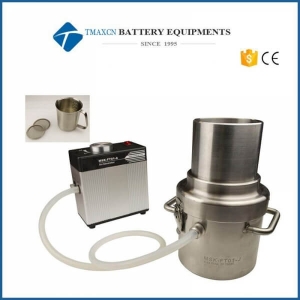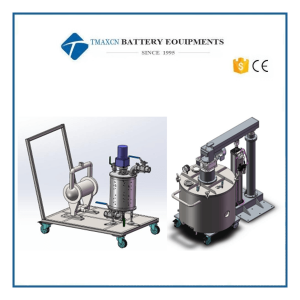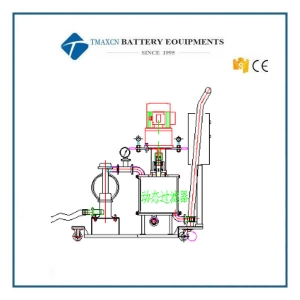products categories
- Battery Production Equipment Line
- Battery Lab Pilot Equipment Line
- Lithium Battery Pack Assembly Line
- Solid State Battery Assembly Line
- Sodium Ion Battery Production Line
- Supercapacitor Assembly Line
- Lithium Ion Battery Recycling Plant
- Dry Electrode Preparation Solution
- Perovskite Based Solar Cell Lab Line
- Li ion Battery Materials
- Cathode Active Materials
- Anode Active Materials
- Customized Battery Electrode
- Coin Cell Parts
- Lithium Chip
- Cylindrical Cell Parts
- Battery Current Collectors
- Battery Conductive Materials
- Electrolyte
- Metal Mesh
- Battery Binder
- Separator and Tape
- Aluminum Laminate Film
- Nickel Strip
- Battery Tabs
- Graphene Materials
- Nickel Felt
- Titanium Fiber Felt
- Battery
- Battery Pack Machine & Compoments
- Battery Pack Compoments
- Turnkey Solutions Battery Pack Assembly Line
- Cell Sorter
- Battery Pack Spot Welder
- Laser Welder
- Battery Charging Discharging Tester
- Battery Pack Aging Machine
- Battery Pack Comprehensive Tester
- CCD Visual Inspector
- Battery Pape Sticking Machine
- BMS Testing Machine
- Al Wire Bonding Machine
- Lithium Battery Machine
- Battery Tester & Analyzer
- Battery Safety Tester
- Material Characterization Tester
- Rolling Press Machine
- Spot Welding Machine
- Vacuum Mixer Machine
- Crimping/Disassembling Machine
- Vacuum Sealing Machine
- Electrolyte Filling
- Stacking/Winding Machine
- Electrode Cutter/Slitter
- Pouch Forming Machine
- NMP Solvent Treatment System
- Lithium Battery Production Plant
- Vacuum Glove Box
- Furnaces
- Coaters
- PVD Coater
- Laboratory Press Machine
- Large Press Machine
- Planetary Centrifugal Mixer
- Ball Mill
- Laboratory Machine
- Cutting Machine
- Metal Foam
contact us
- If you have questions, please contact us, all questions will be answered
- WhatsApp : +86 18659217588
- Email : David@tmaxcn.com
- Email : Davidtmaxcn@gmail.com
- Add : No. 39, Xinchang Road, Xinyang, Haicang Dist., Xiamen, Fujian, China (Mainland)
-
 Compact Filtration/Sieving System (750mL) for Electrode Slurry
Compact Filtration/Sieving System (750mL) for Electrode Slurry
Compact Filtration/Sieving System (750mL) for Electrode Slurry
-
 Magnetic De-ironing Filtration System for Battery Electrode Slurry
Magnetic De-ironing Filtration System for Battery Electrode Slurry
Magnetic De-ironing Filtration System for Battery Electrode Slurry 1.Introduction This equipment is a specific feeding equipment for lithium ion battery coating machine, which is composed of two parts: turnover barrel + iron removal filter. 2.Standard composition and key configuration table 2.1Turnover barrel and lifting part 1.Feeding barrel Design volume/use volume 150L/100L The material of the inner tank of the mixing tank in contact with the material: 304 stainless steel. Mixing barrel specification About φ650*450 1) Discharge valve: G2” (DN50); 2) The barrel body has push and pull handles, and the barrel bottom has 4 casters (2 orientation + 2 universal); 3) Cooling/heat preservation: with bottom/side wall cooling jacket, cooling water inlet/outlet water distribution pipe union 2.Upper cover Upper cover specification Match with the corresponding mixing tank The material of the part in contact with the material: 304 stainless steel. 1), with 2 small windows, a spotlight, feeding tube DN25 (with 304 ball valve), suction/discharge vacuum interface, vacuum pressure gauge and other spare connections; 2) The upper cover and the mixing barrel are fixed and locked with quick-locking buckles. 1. Mixing accessories and basic parameters Mixing shaft/Mixing paddle speed About 25rpm Material: SUS304 Mixing motor power 1.1kw/4P Reducer(matched with motor) NMRV-090-60-FA-F2-Y90S-1.1KW Mixing paddle form Combined frame type mixing paddle. 4.Mixing principle The combined frame-type mixing paddle performs downward pressure rotation to ensure that the material does not deposit. 5.Vacuum guarantee system: 5 skeleton oil seals are installed in parallel, and the vacuum source is provided by the user 1), the vacuum degree is ≤-0.098Mpa, keep for 24 hours not less than -0.08Mpa. 2) Sealing method: A, static seal uses "O"-shaped sealing ring; B, skeleton oil seal. 6. Power distribution box: the stirring switch, spotlight switch, emergency stop and other functional operations during equipment operation are all carried out on the power distribution cabinet. 7. Lifting device: 1 φ125x800 lifting cylinder, equipped with 1 safety pin 2.2Iron removal filter part No. Name Material Note 1 Shaft seal Viton Wear-resistant and corrosion-resistant 2 Blade Polyester plastic (imported from UK)Wear-resistant and corrosion-resistant 3 Blade spring SUS304 4 Sealing ring Silica gel 5 Shaft assembly EPDM+SUS304 6 Filter element SUS316 Accuracy deviation value: ±0.03mm (maximum ±0.05mm), diameter deviation value: ±0.3mm 80 mesh to 200 mesh optional (standard 120 mesh) 7 Shell/Upper and Lower Plate Cover/Blade Holder SUS304 8 DC motor 24V/60W 9 Separator pump Aluminum alloyQBY-25 3.Liquid level sensing system Working principle: The liquid level sensor transmits the signal to the solenoid valve according to the change of the material liquid level, and the solenoid valve controls the feeding amount of the pneumatic diaphragm pump, thereby realizing the function of automatic feeding. No. Name Model Quantity Note 1 liquid level sensor Domestic brand 1 2 The electromagnetic valve Taiwan 1 3 Intermediate relay Domestic brand 1 4 Intermediate relay holder Domestic brand 1 5 Rotary Switches Domestic brand 1 4.Principle This equipment is filled with dry compressed air into a sealed pressure barrel, and pressurizes the inner cavity of the pressure barrel to press the slurry into the upper trough of the coating machine.
-
 Compact Filtration/Sieving System (750mL) for Electrode Slurry
Compact Filtration/Sieving System (750mL) for Electrode Slurry
Compact Filtration/Sieving System (750mL) for Electrode Slurry
-
 500mL Compact Battery Electrode Slurry Filtration System
500mL Compact Battery Electrode Slurry Filtration System
500mL Compact Battery Electrode Slurry Filtration System Product Description This filtration device is primarily used for laboratory-scale nano-level slurry filtration. It features an aesthetically pleasing design and offers flexible and convenient operation. This machine is specifically designed for laboratory research on various battery types, including coin cells, pouch cells, cylindrical cells, and other battery formats, making it highly versatile for battery development and testing. Features & Functions · High filtration precision, reaching up to 124 microns, equipped with filtration meshes for both cathode and anode particles. · Full SUS304 stainless steel construction, ensuring excellent corrosion resistance and easy cleaning. · Large filtration area, minimizing pressure loss and enhancing durability. · Compact size for easy operation. · Elegant appearance, easy maintenance, and durable structure. Technical Specifications Parameter Specification Filter Dimensions 145 × 150 × 200mm Air Generator Dimensions 140 × 70 × 150mm Power Adapter AC 220V ±10% 50Hz(customizable) Absolute Vacuum Level 65KPa Air Pump Flow Rate 3L/min Standard Filter Mesh 80, 100, 150 mesh Optional Filter Mesh Up to 1000 mesh Capacity 500ml (customizable)
-
 Lithium Battery Slurry Resistance Tester
Lithium Battery Slurry Resistance Tester
Lithium Battery Slurry Resistance Tester Introduction TMAX-BSR2300 use the upper, middle and lower three pairs of electrodes to test the resistivity of the slurry at different vertical heights, evaluate the conductivity of different formulations of slurry and the settlement performance with the standing time. Assist R&D in slurry formulation development and mixing process stability monitoring. Characteristic 1. Applicable to the conductivity evaluation of lithium (sodium) slurry and conductive agent slurry, to assist in research and development. 2. Separate the voltage and current lines, eliminate the influence of inductanceon voltage measurement, and improve the accuracy of resistivity detection. 3. The disc electrode with a diameter of 10mm ensures a relatively large contactarea with the sample and reduces the test error. 4. Three pairs of electrodes test the slurry resistivity and identify the slurry sedimentation performance. 5. Monitoring the changes of resistivity ofthe slurry in real time at threepositions in the vertical direction over time. Application 1. Lithium (sodium) battery positive and negative electrode slurries 2. Conductive agent slurries material evaluation 3. Formula evaluation 4. Sedimentation performance evaluation. Product Description Disperse the powder into the liguid., Add it dropwise to the glass slide. Locate the single particle under an optical microscope. Control the pressure head to press down at a constant speed. Collect the force and displacement curves during the particle compression process and calculate the mechanical properties of the single particle. 1. The Significance of Slurry Resistivity The slurry is an important intermediate product in the production of lithium-ion batteries. The uniformity and stability of the slurry greatly affect the consistency and electrochemical performance of the final battery cell. The current method of monitoring slurry only has viscosity parameters, which cannot accurately evalu- ate the uniformity and stability of its electrical proper- ties. However, the slurry conductivity parameters and slurry formulation, conductive agent type and content, binder type andcontent etc, which all have significant correlation to monitor the production of slurry, and the slurry may have gel sedimentation after dwelling for a period of time after mixing. At this time, the conductivity value will also show varying degrees of change. Therefore, the conductivity of the slurry can be used as a method to characterize the uniformity and stability of the electrical properties of the slurry. Monitoring the conductivity of the slurry, not only , it can evaluate the infuence of diferent active materials.conductive agents, binders, solid content, etc, on the electrochemical performance of the slurry, but alsoit can also be used for, monitoring the process stability, which can quickly identify abnormalities in the mixingprocess, and avoid the waste of time and cost caused by defective slurry flowing into the subsequent process. 2. Battery Slurry Resistivity Test Principle Test steps: Putting a certain volume of slurry (~80mL) into the measuring glass, inserting a clean electrode pen, start the software, start to test the changes in the slurry resistivity at the three pairs of electrodes over time and save it in the file. Test parameters: Resistivity, Temperature, Time Calculation formula: Features 1) Applicable to the conductivity evaluation of lithium (sodium) slurry and conductive agent slurry, to assist in research and development. 2) Separate the voltage and current lines, eliminate the influence of inductanceon voltage measurement, and improve the accuracy of resistivity detection. 3) The disc electrode with a diameter of 10mm ensures a relatively large contactarea with the sample and reduces the test error. 4) Three pairs of electrodes test the slurry resistivity and identify the slurry sedimentation performance. 5) Monitoring the changes of resistivity ofthe slurry in real time at threepositions in the vertical direction over time. 3. Slurry Resistivity Analyzer MSA Test program: Three operators, five parallelsamples, and random testing Test method: Sonicating the electrode pen withdeionized water for 30 seconds,and drying it with the dust-freepaper. Then five parallel sampleswas tested, and the fifth set of datawas taken for the GRR analysis Application Cases Case 1. Evaluation of Conductive Agent Slumy With Different Fommulations 1) When the viscosity, concentration and dispersant type of the conductive agent are changed, the resistivity also changes! 2) In the future, specifications can be forrmulated for the slurry resistivity of a certain fixed viscosity, and the stability of the slurry process can be monitored! Case 2. Concentration-Viscosity-Resistivity Correlation 1) The resistivity of the slurry decreases with the increase of the concentration, and the change of the viscosity is also inversely proportional to the relationship; 2) The I-V curve test of these two types of slurries basically conforms to Ohm’s law, and the current and voltage have a linear relationship, indicating that the slurries are mainly electronic conductors; Case 3. Slurry Settling Performance 1) On the first and fourth day of testing, the resistivity of the upper and middle channels increased, while the resistivity of the lower channel decreased, indicating that after four days of shelving, the slurry shows obvious settlement. 2) Subsequently, a shelving period can be formulated for a certain of slurry according to the change of the resistivity to ensure the uniformity of the slurry! Specifications
-
 High-Precision Slurry De-ironing Filtration & Transfer System
High-Precision Slurry De-ironing Filtration & Transfer System
High-Precision Slurry De-ironing Filtration & Transfer System I. Flow Diagram & Description: #1 Scheme: #2 Scheme: 1. The slurry contained in the transfer tank is conveyed via a diaphragm pump through filtration and iron-removal equipment before being delivered to the coating machine's hopper. 2. All components are interconnected using quick-release couplings and mounted on a stainless steel tray. The slurry transfer process is regulated by the piping network and control system. 3. Crucial Note: The connecting pipeline valves and level control mechanisms between this system and the coating hopper/storage tank must be installed and managed by the end-user and coating machine supplier, as these elements are specifically tailored to your facility and selected coating line configuration. II. Equipment Composition & Capacity: No. Name Model/Specification Unit Qty Remarks 1 Pneumatic double diaphragm pump 3/4″ – S.K.Y. or Graco pcs 1 With standard ISO quick connect 2 Filter cartridge Φ76 × 200 mm pcs 1 100–250 mesh 3 Magnetic rod Φ25 × 156 mm pcs 3 10,000 Gauss each 4 Pressure gauge Ø60 mm – 1 MPa pcs 1 SUS304 stainless steel 5 Squeegee (scraper) 3 piece scraper set pcs 1 Squeegee material: PTFE (Teflon); Spring in Japanese stainless steel 6 Connection tube/valve/fittings Ø25 mm set 1 SUS304 stainless steel 7 Stainless steel tray Non standard (L×W×H) mm pcs 1 SUS304 stainless steel 8 System control cabinet Level, pressure, alarm, control pcs 1 SUS304 stainless steel 9 Conveyance capacity Operating capacity: 20 L/min – – – III. Other Instructions & Cautions: 1. Shaft seal, squeegee, and filter cartridge are consumable parts. 2. This system is intended for a single slurry formulation in continuous production—frequent batch changes or intermittent operation should be avoided. 2 1. When changing slurry types, flush pipes and magnetic filters, and replace key parts (filter cartridge, mesh), and preferably replace piping too. 2 2. During normal operation, ensure the pipelines remain filled with slurry to prevent air ingress and moisture, which can cause slurry solidification. 2 3. External dimensions: 500 mm × 1000 mm × 900 mm (L × W × H).
-
 200L Pneumatic Lifter for Mixer
200L Pneumatic Lifter for Mixer
200L Pneumatic Lifter for Mixer I. Equipment Features Application Scope l Lifting the transfer barrel cover assembly. II. Main Equipment Parameters Control System & Performance l Air Pressure: 0.5 – 0.6 MPa (dry compressed air) l Air Consumption: 15 L/min l Lift Control Panel: Manual directional valve with self‑lock l Control Mode: Manual l Rated Load: ≤ 360 kg l Machine Weight: ≈ 420 kg l Dimensions: L 1290 × W 1220 × H 1691 mm (raised 2491 mm) l Color: Off‑white l Floor Load: 400 kg/m² III. Key Components Brand No. Item Spec. Material Qty Brand 1 Cylinder ΦD × ΦN Al‑alloy 1 Airtac 2 Pneumatic Valve – – 1 Airtac IV. Supporting Conditions No. Item Standard Requirements 1 Workshop Height > 2.5 m; ensure lift clearance 2 Door Size H > 2.0 m; W > 1.0 m 3 Heating Room > 20 °C to keep lubricants fluid 4 Installation Space As per layout 5 Others No corrosive / explosive gases or liquids Slurry De-Ironing, Filtration & Transfer System Model: HDCG-3/4"-3 I. Process Diagram & Description 1. Slurry stored in the transfer tank is pumped (diaphragm pump) through pipelines for filtration & de‑ironing, then delivered to the coating‑machine hopper. 2. All components are connected via quick fittings and fixed on a stainless tray; transfer is managed by the control system & piping. 3. Note: Valve & level‑control between this system and the coating hopper/tank shall be installed and managed by the customer & coater supplier. II. Equipment Configuration & Capacity No. Name Spec. / Model Unit Qty Remarks 1 Pneumatic Diaphragm Pump 3/4" – Skylink or Graco set 1 with ISO quick clamp 2 Filter Cartridge Φ76 × 200 mm (100–250 mesh) pc 1 – 3 Magnetic Bars Φ25 × 156 mm, 10 000 GS pc 3 – 4 Pressure Gauge Φ60, 0–1 MPa, SUS304 pc 1 – 5 Scraper Assembly Triple‑blade, PTFE scrapers / SS springs set 1 – 6 Tubes & Valves Φ25, SUS304 set 1 – 7 Stainless Tray Custom size (L × W × H) pc 1 SUS304 8 Control Box Level, pressure, alarm, control pc 1 SUS304 9 Transfer Capacity 20 L/min – – working flow III. Additional Notes & Precautions 1. Shaft seals, scrapers, and filter elements are consumables. 2. System is intended for single‑slurry, continuous production; frequent formulation change or batch interruption is discouraged. 3. When changing material system, clean lines & magnetic filter and replace key parts (filters), preferably new tubing. 4. Keep pipelines filled with slurry to avoid air/moisture ingress that may cause gelation. 5. Overall Dimensions: L 500 × W 1000 × H 900 mm
 ru
ru
 +86 13174506016
+86 13174506016 David@tmaxcn.com
David@tmaxcn.com

